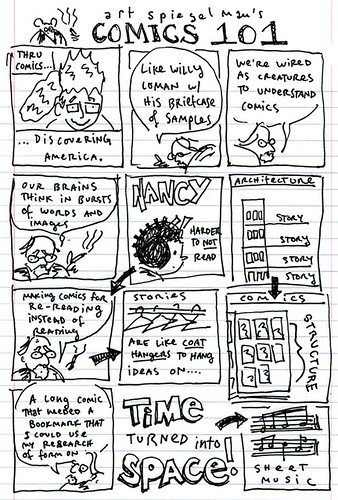My feeling is that these modalities have already changed reading and writing practices, and therefore will assume a place in the classroom eventually, whether one likes it or not.
In the Baron reading entitled “Instant Messaging and the Future of Language”, it is claimed that “the IM behavior of many younger teens is not generally reflected in the language patterns we find in contemporary college students” (Baron 30), yet I find many such ‘behaviors’ interpolated throughout much of the informal conversation amongst students on campus. But I don’t find this a problem – it is just another register to be learnt and deployed when appropriate. Baron goes on to say that “the most important effect of IM on language turns out to be not stylized vocabulary or grammar but the control seasoned users feel they have over their communication networks” (Baron 30). The control referred to here is simply multitasking i.e. students like to engage in multiple IM conversations while doing homework and listening to music etc. Multitasking is said by the New Media set to be a skill acquired only after practicing these new forms of reading and writing, yet although that might well be true, so what? The relevant question to me is whether or not there is a preponderance of studies that demonstrate that multitasking furthers academic language acquisition and sophisticated deployment of various academic registers in various modalities for a variety of ends. My concern is that the claim is just another pseudo-intellectual shibboleth the New Media gurus like to parade around in the hope that if it’s repeated often and loud enough the paying public will start believing it. If there are such studies, how authoritative are they and the academics that designed/conducted them? How independent from corporate influence were they?
In other words, how are we to know, really?
Moving on, Baron unwittingly reveals her unease with the potential influence that IM may have on normative language standards – despite her earlier claim that its influence is benign – when she claims that “IM is unlikely to play a significant role in altering writing standards—unless we as parents and educators let it” (Baron 31). In other words, IM is felt to be potentially harmful, and “unless society is willing to accept [teens] spelling their names six different ways or using commas, semicolons, and periods according to whim… parents and teachers must provide good models and, if necessary, even gentle sticks” so that “teens are also able to master more formal written language style” (Baron 31). The assumption is that teens are incapable of understanding the distinction, or incapable in general, and I suggest that this arises from a deeper anxiety around being displaced, of being inevitably rendered irrelevant. If boomers were in fact immortal and not just desperately frightened of death, I doubt there’d be this amount of fuss, a point which makes for a good segue-way to the next reading, which is playfully entitled “Txting: the end of civilization (again)?”
The txt quote below was submitted electronically by an unnamed 13 year old Scottish girl as her essay assignment regarding her summer holidays, and starts the kerfuffle that resulted in a string of shrill online articles about the putatively corrosive effect of kids’ txting on “standard” language:
“My smmr hols wr CWOT. B4, we used 2go2 NY 2C my bro, his GF & thr 3 :- kids FTF. ILNY, it’s a gr8 plc.”
The translation of this txt essay on offer in the reading is as follows:
“My summer holidays were (a) complete waste of time. Before, we used to go to New York to see my brother, his girlfriend and their three screaming kids face to face. I love New York. It’s a great place.”
The articles that resulted from this txt essay are said to have created “a discursive chain linking txting to youth to declining standards to poor academic achievement to social breakdown” (Carrington 163). Txting is said to be “represented as the abnormal intruder” (Carrington 167), and that youth are portrayed as “addicts” of txting (Carrington 167). The breathless hyperbole on display in the articles, the caricature of the girl as a nameless, faceless addict, are all evidence of the deeper anxieties I mentioned above. My generation learned to “shift between various types and forms of textual and other language use on a daily, even hourly basis in the course of our daily activities” (Carrington 167), despite the fact that we voraciously read comic books and pulp fiction, and despite the desperately dire warnings that these ‘low-brow’ literary forms would ‘rot our brains’.
In other words, it was ever thus.
Ostensibly, the anxiety is rational – if one is to do well on standardized exams, one must be able to deploy an unsullied “Standard English”, as if that “Standard” encapsulated all that one should ever aspire to be, for as long as the ideologies and biases etc. remain unexamined, perhaps we can continue to live within our capitalist utopia despite all the evidence to the contrary. The “examinations have become firmly established as a high stakes, highly particularized form of textual practice that are shrouded in an institutional aura of difficulty and secrecy” (Carrington 168) for a very simple reason: if the edifices upon which they are constructed were ‘examined’ themselves, the game would be up. Teachers who allow for linguistic evolution and those students who choose to deploy their new understandings in unsanctioned ways are in the articles constructed as Other – ie as threats: the articles “collude to guide the reader to a view of txting as a spoiled version of legitimate text and language use, used by individuals—always young— taking shortcuts and falling victim to a ‘fad’” (Carrington 169). Teachers horrifyingly just may, “wittingly or unwittingly, provide students with the skills to enact substantive social change” (Carrington 169).
So it makes perfect sense that the current hysteria around ‘eroding language standards’ as a result of new modes of text production is constructed unconsciously by the status quo as “a ‘moral’ decline (Carrington 171), rather than it just being okay for it to be about changes in the status quo. “Literacy is always a litmus paper for social change and the tensions this creates and the same increasingly holds true in relation to popular culture” (Carrington 171).
Problematically for me, Carrington herself seems rather too concerned with how to ensure that our students learn the multiliteracy skills they will need to participate “in economic and information flows” (Carrington 172), which for me sounds like code for making money. This is rather too vocational for my tastes, and really when you think about it, how is that end any different than the one our current masters are bent on enforcing?
Finally, I also think we have to be careful not to pretend that the unnamed 13 year old girl who was simply venting about her lousy summer vacation was doing anything other than venting. She was not CONSCIOUSLY revolutionizing classroom discourse. When Carrington claims that “her use of txting was, in fact, quite sophisticated and she was clearly experimenting with how far into other discursive spaces her mastery of txting could reach” (173), I had to roll my eyes. She was NOT “demonstrating literate skills, utilizing new technologies to carry out social functions,” nor was she carving “out a [new] identity within particular semiotic domains” (Carrington 173). There is no irony in the girl’s txt – it was simply that she was too lazy and pissed off to do anything else… but it was a good first step on the road to inventing an independent future for herself, where she could be conscious, and in ways hopefully that none of the current gatekeepers can predict.
Baron, N. (2005). Instant messaging and the future of language. Communications of the ACM, 48(7), 29-31.
Carrington, V. (2005). Txting: The end of civilization (again)? Cambridge Journal of Education, 35(2), 161-175.


